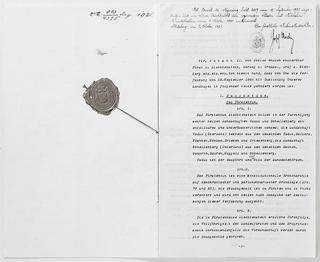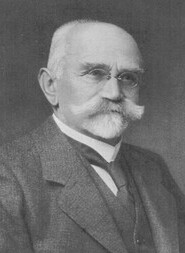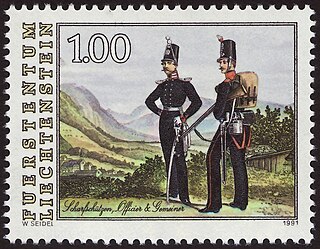
Liechtenstein, officially the Principality of Liechtenstein, is a doubly landlocked German-speaking microstate in the Central European Alps, between Austria in the east and north and Switzerland in the west and south. Liechtenstein is a semi-constitutional monarchy headed by the prince of Liechtenstein of the House of Liechtenstein, currently led by Hans-Adam II. It is Europe's fourth-smallest country, with an area of just over 160 square kilometres and a population of 40,023. It is the world's smallest country to border two countries, and is one of the few countries with no debt.

Political identity came to the territory now occupied by the Principality of Liechtenstein in 814, with the formation of the subcountry of Lower Rhætia. Liechtenstein's borders have remained unchanged since 1434, when the Rhine established the border between the Holy Roman Empire and the Swiss cantons.

Vaduz is the capital of Liechtenstein and also the seat of the national parliament. The village, which is located along the Rhine, has 5,696 residents. The most prominent landmark of Vaduz is Vaduz Castle, perched atop a steep hill overlooking the village. It is home to the reigning prince of Liechtenstein and the Liechtenstein princely family. The village's distinctive architecture is also displayed in landmarks such as the Cathedral of St. Florin, Government House, Village Hall, the National Art Gallery, as well as the National Museum. Although Vaduz is the best-known village in the principality internationally, it is not the largest; neighbouring Schaan has a larger population.

Schellenberg is a municipality in the lowland area of Liechtenstein, on the banks of the Rhine. As of 2019, it has a population of 1,107 and covers an area of 3.5 km2 (1.4 sq mi)

The Constitution of the Principality of Liechtenstein was promulgated on 5 October 1921, replacing the 1862 constitution.

Vaduz Castle is the palace and official residence of the Prince of Liechtenstein. The castle gave its name to the town of Vaduz, the capital of Liechtenstein, which it overlooks from an adjacent hilltop.

Bendern is a village of Liechtenstein, together with the town of Gamprin it forms in the municipality of Gamprin. It is the third smallest in the country, with an area of 6.19 km2 and a total population of 1664 people. The village itself had about 470 residents.

Eschnerberg, also Eschner Berg, Schellenberg, is 698 m high mountain of seven peaks in the Rhine Valley, on the borderline of Liechtenstein and the Austrian state of Voralberg, close to Feldkirch.
Schalun Castle, also known colloquially as Wildschloss, is a castle ruin located in the municipality of Vaduz, Liechtenstein. It lies in the mountains, roughly 1 kilometer to the northeast from the town centre of Vaduz, the capital of Liechtenstein. It is freely open to tourists and accessible by foot or mountain bike via a local footpath. Schalun Castle is one of the five existing castles in Liechtenstein and one of the three ruined ones in the country.

Obere Burg, also known colloquially as Burg Neu-Schellenberg, is a castle ruin located in the municipality of Schellenberg, Liechtenstein. It lies at the western edge of Hinterschloss, one of the burroughs in the village of Neu-Schellenberg. It is freely open to tourists. Due to its close proximity to Hinterschloss, it is probably the most easily accessible of all Liechtenstein castles. Obere Burg is one of the five existing castles in Liechtenstein and one of the three ruined ones in the country.

Gutenberg Castle is an intact castle in the town of Balzers, Liechtenstein, in the centre of the municipality of Balzers, the southern-most municipality in the country. Gutenberg is one of the five castles of the principality and one of two that have survived intact until the present day.

Schauenburg Castle is a ruined hilltop castle located in Oberkirch, Germany, atop a 367-metre-high (1,204 ft) (NN) hill spur overlooking the Rench river valley above the town of Gaisbach, Baden-Württemberg. The castle was built by Duke Berthold II of Zähringen.

Georg Malin is a Liechtensteiner artist, sculptor, historian and politician. Between 1974 and 1978, Malin served as member of the governing council in the Liechtenstein government, for the Progressive Citizens' Party (FBP). He previously served as a member of the Landtag of Liechtenstein from 1966 to 1974, where he was also a member on the parliamentary delegation to the European Council.

Peter Geiger is a historian from Liechtenstein and former research officer at the Liechtenstein Institute for history. He primarily focuses on Liechtenstein in the 1930s and World War II.

Albert Schädler was a Liechtenstein politician, physician, and historian. He served as the President of the Landtag of Liechtenstein from 1882 to 1886, and again from 1890 to 1919. A member of the prominent 19th-century Schädler family, he was well regarded as a physician and politician, and influenced the country's politics for decades.

Peter Rheinberger was an engineer and captain in the Liechtenstein military. He later became a political figure and served in the Landtag of Liechtenstein. He was a member of the prominent Rheinberger family.

The military history of Liechtenstein originates back to its predecessors in the County of Vaduz and Lordship of Schellenberg. Liechtenstein disbanded its army in 1868, and has had no standing army since. However, under the constitution of Liechtenstein citizens are still obligated to defend the country in the event of an external threat, and the army may be reformed if deemed necessary.
Rupert Quaderer is a historian from Liechtenstein and former research officer at the Liechtenstein Institute for history. His works have included numerous publications on the political and diplomatic history of Liechtenstein.























